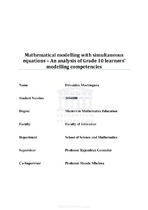| dc.description.abstract | Mathematical modelling is gaining extensive interest across the schooling sector worldwide, as it is deemed to develop learners with competencies set to deal with the demands of the fourth industrial revolution and being creative problem solvers. As mathematical modelling has only recently gained momentum across the mathematics curricula for schools in South Africa, many teachers may not be aware of the competencies that are needed to be developed in their learners through solving word problems, and even learners may not be aware of these essential modelling competencies. Hence, this mixed-methods approach study adopted a case-study design located within an interpretative paradigm to explore the levels of mathematical modelling competencies a sample of Grade 10 learners attending a Western Cape School demonstrated as they solved a set of word problems associated with the use of simultaneous equations. Additionally, data collected through observations and limited sets of semi-structured interviews were considered in the data analysis processes, which were largely driven by qualitative content analysis methods and supplemented with elementary descriptive statistical methods.
The findings of this study showed that most of the learners demonstrated non-competency in modelling mainly because of their inability to understand the problem as evident in their failure to comprehend the context of a problem, inability to recognise important quantities associated with a problem, and muddled relationships if any. The study conjecture that the use of the English language could have been a barrier to the sample of English second language speakers understanding the problem. However, a very limited number of students showed partial modelling competency, as they were only able to understand the problem and build a correct model to solve the problem. Regrettably, these students lacked the knowledge of the heuristics for solving a system of linear equations correctly and completely and did not check or verify their answers. The extremely small number of learners, who demonstrated sufficient modelling competency, demonstrated sufficient understanding of the problem, built and solved the system of simultaneous linear equations successfully without necessarily checking or testing whether their answers satisfied the conditions of the problem. Hence, this study recommends that adequate focus be given to the role of language in understanding a problem, heuristic competencies to solve a system of linear equations should be strengthened, and the habit of checking the reasonableness of the solution should be encouraged and developed continuously across problem-solving tasks. Studying learners’ modelling competencies requires further work to add to the repertoire of this knowledge domain. | en_US |

